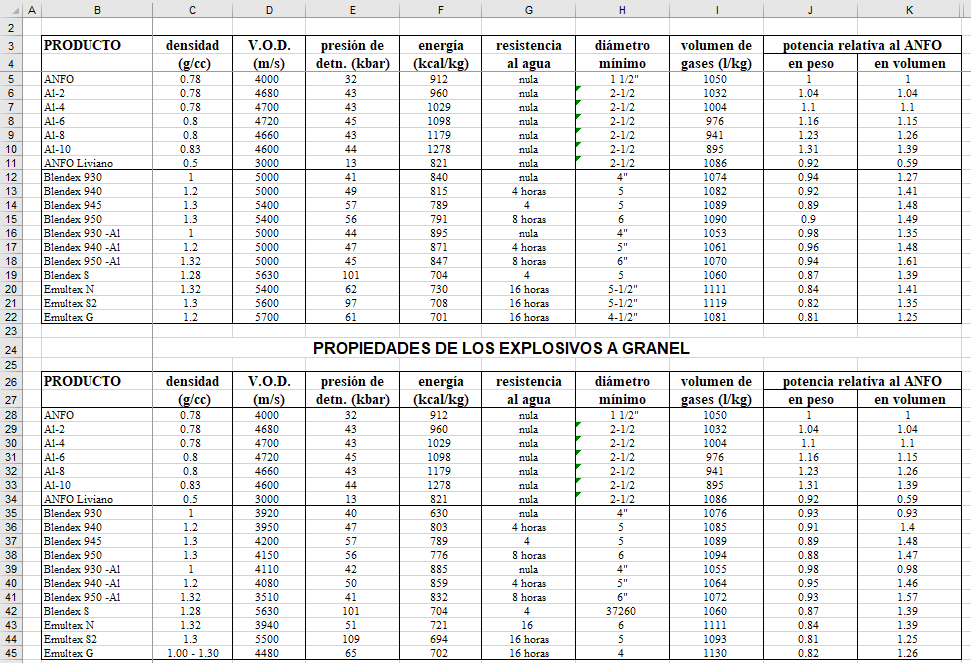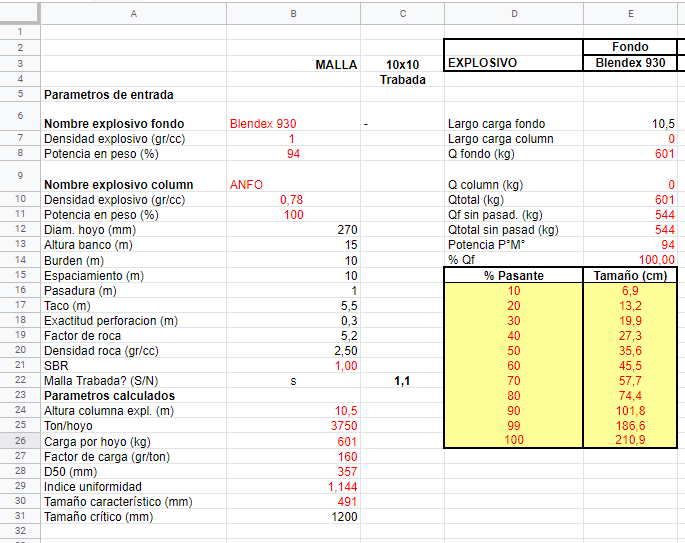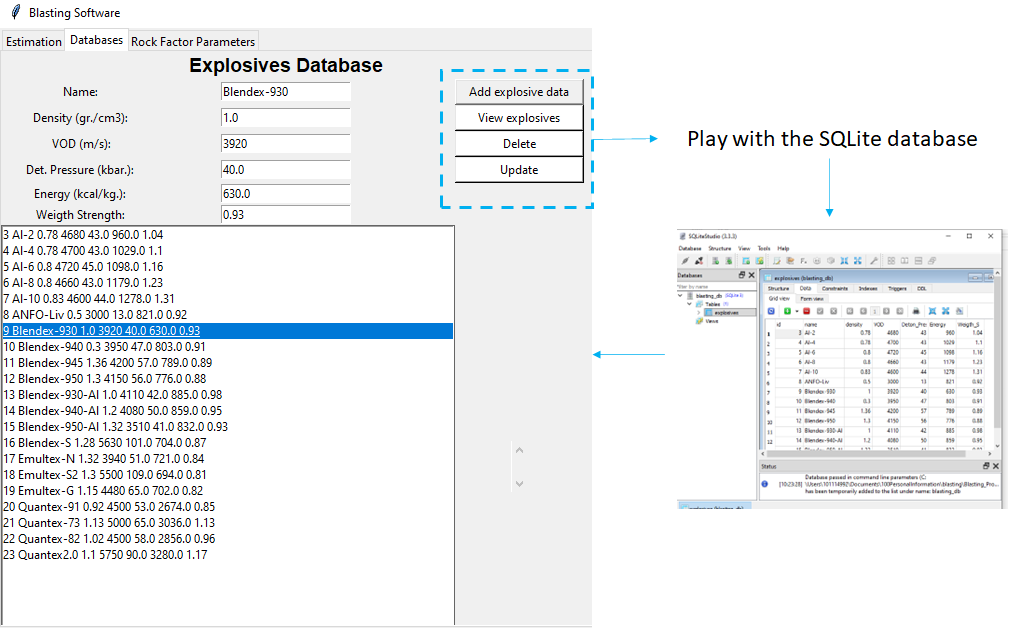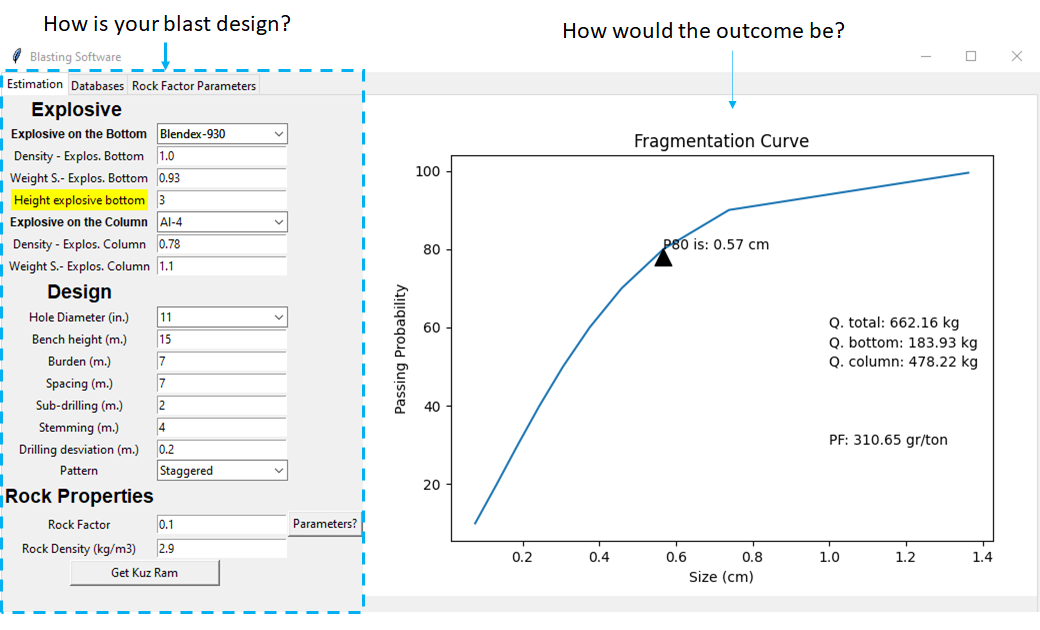

Programming Language: Python
Relational Database Management System: SQLite
1. Problem statement
2. The solution
2.1 Building an application
3. Application’s features
4. Future work ideas
5. Code source
When analyzing a blasting design in an open pit mining operation, we usually find explosives data saved in excel sheets that needed to be copied and pasted into a report format and then looked up.
 |
|---|
| Row explosives data |
Blasting engineers often use this row data to predict how fragmented the rock will be after being blasted - this is based on computing some equations, i.e., Kuz Ram model. It is most likely to find this analysis in Excel files such as the following: engineers will need to look up the explosives properties in another table and then find the best blasting parameters.
 |
|---|
| Report in an Excel file format |
So, how can we keep the source data for a blasting design and their corresponding computations?
Instead of keeping using Excel files to store and perform computations, we thought about building a desktop graphical user interface (GUI) that could handle the two main processes of getting a Kuz-Ram curve (also see picture below):
 |
|---|
| Prospective solution |
The GUI was built with Tkinter, which offers multiple features for desktop applications.
1- Inserting, viewing, updating, and deleting data in a database table
Once we got a SQLite database (located in the Github_repo), we could perform multiple operations:
class Dabase:
def __init__(self, db):
"""
Connects to the dbase.
Args:
db (.db file): path of the db file
"""
# Connect to db
self.conn = sqlite3.connect(db, check_same_thread= False)
# Allow to execute statements
self.c = self.conn.cursor()
# Make sure that the table for explosives exist
self.c.execute(
"CREATE TABLE IF NOT EXISTS explosives \
(id INTEGER PRIMARY KEY, name FIXED,\
density FLOAT, VOD INTEGER,\
Deton_Pressure FLOAT, Energy FLOAT, Weigth_S FLOAT)"
)
def insert(self, name, density, vod, detpre, energy, wes):
"""
Insert properties for a new explosive. This comes from some input boxes
Args:
name (str) : Name of the explosive
density(float) : Density of the ..
vod (float) : Velocity of detonation
detpre (float) : Detonation Pressure
energy (float) : Energy
wes (float) : Weigh pressure compared to ANFO
"""
# First one for id
self.c.execute(
"INSERT INTO explosives VALUES (NULL, ?, ?, ?, ?, ?, ?)",
(name, density, vod, detpre, energy, wes)
)
self.conn.commit()
def view(self):
""" Show row data from explosives table in the GUI"""
self.c.execute(
"SELECT * from explosives"
)
# Show them in a list - this is the best way
# to show data in Tkinter TODO: might be another though
rows = self.c.fetchall()
return rows
def update(self, id, name, density, vod, detpre, energy, wes):
""" Will update the database if row added from insert method"""
self.c.execute(
"UPDATE explosives SET name = ?, density = ?, \
VOD = ?, Deton_Pressure =?, Energy = ?, \
Weigth_S = ? WHERE id = ?",
(name, density, vod, detpre, energy, wes, id)
)
self.conn.commit()
2- Compute all variables for Kuz-Ram model
Even though one method from the app frontend will be described here, this is not fully described here. Please, check the frontend-code for more information.
def solve_kuz_ram():
h_column = float(textbh.get()) - float(textstem.get()) + float(textsd.get())
# Tons/hole
ton_hole = float(textbi.get()) * float(textsi.get()) * float(textbh.get()) * float(textrd.get())
# Height of explosive that is in the column (this is different dfor the bottom)
h_explosiv_column = h_column - float(texthf.get())
# Q for bottom as well for column
# Texthf is height of explosive at the bottom
bottom_charge = 0.5067 * float(
text_dens.get()
) * (float(hole_diameter_text.get()) **2) * float(texthf.get())
column_charge = 0.5067 * float(
textdec.get()
) * (float(hole_diameter_text.get()) **2) * h_explosiv_column
subdrilling_charge = 0.5067 * text_dens.get() * (
float(hole_diameter_text.get()) **2
) * float(textsd.get())
# total Q, stemming is included
total_charge = bottom_charge + column_charge
# total Q, stemming is not included
total_charge_nostem = total_charge - subdrilling_charge
# WS of the whole hole
total_weight_strenght = 100*(
float(textweb.get()) * (bottom_charge - subdrilling_charge) + float(textwec.get()) * column_charge
)/(bottom_charge + column_charge - subdrilling_charge)
# Power factor, which is in gr/ton
power_factor = total_charge * 1000 / ton_hole
# 50 prob which is in mm
# textrf is rockfactor
# textrd is rockdensity
d_50 = float(textrf.get()) * 10 * (
(ton_hole /(float(textrd.get()) * total_charge)
)**0.8
) * (total_charge **(1/6)) * ((115/total_weight_strenght) ** 0.633)
# Uniformity index
if pattern_text.get() == "Staggered":
pattern_value = 1.1
else:
pattern_value = 1
uniform_index = pattern_value * (
(
h_column - float(textsd.get())
)/float(textbh.get()) * (
2.2 - 14 * float(textbi.get())/(float(hole_diameter_text.get()) * 25.4)
) *(
(1 + float(textsi.get())/float(textbi.get()))/2
) ** 0.5 * (1 - (float(textdd.get())/float(textbi.get()))) * (
abs(bottom_charge - column_charge) / (bottom_charge+column_charge) + 0.1
) ** 0.1
)
uniform_index = round(uniform_index, 2)
#Particular size
particular_size = d_50 / (0.693 ** (1/uniform_index))
particular_size = round(particular_size, 0)
There are two main feature in this application:
 |
|---|
| Databases tab - GUI |
 |
|---|
| Estimation tab - GUI |